Project Quality Scope Management Essay for PMC 204 Course
VerifiedAdded on 2023/06/10
|12
|3066
|108
Essay
AI Summary
This essay provides a comprehensive overview of project quality scope management, beginning with the definition and evolution of quality management. It delves into various quality tools such as Total Quality Management (TQM), Six Sigma, ISO standards, and Lean Methodology, highlighting their roles in ensuring project success and customer satisfaction. The essay also discusses the Wheel of Quality, emphasizing customer focus, variation management, continuous improvement, and essential elements like training and leadership. Furthermore, it examines ISO 9001 quality conformance requirements, including the development and essential elements of a quality policy, manual, objectives, procedures, and documentation. The essay concludes by underscoring the importance of quality management in achieving project goals and meeting customer expectations. Desklib offers a variety of resources, including similar solved assignments and past papers, to aid students in their studies.
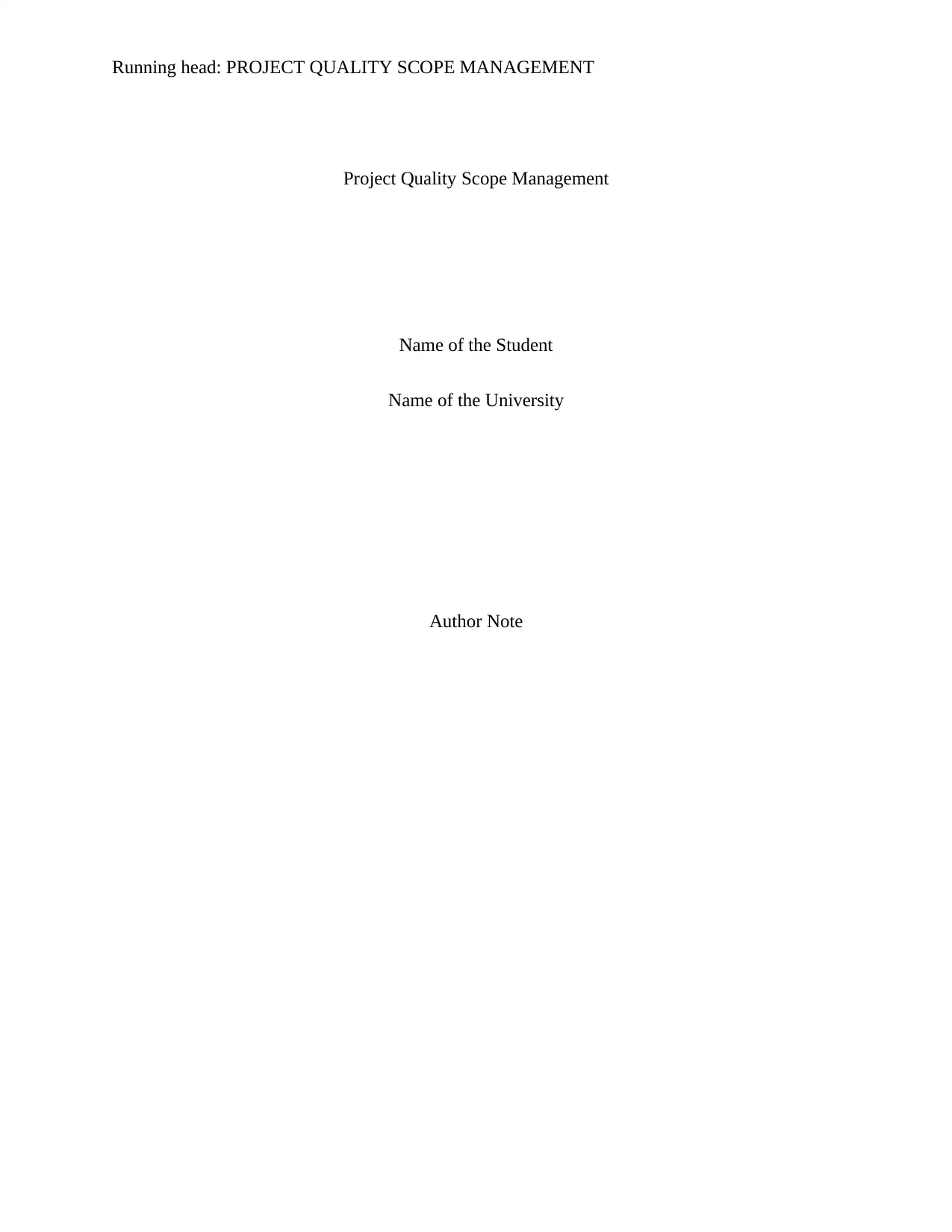
Running head: PROJECT QUALITY SCOPE MANAGEMENT
Project Quality Scope Management
Name of the Student
Name of the University
Author Note
Project Quality Scope Management
Name of the Student
Name of the University
Author Note
Paraphrase This Document
Need a fresh take? Get an instant paraphrase of this document with our AI Paraphraser
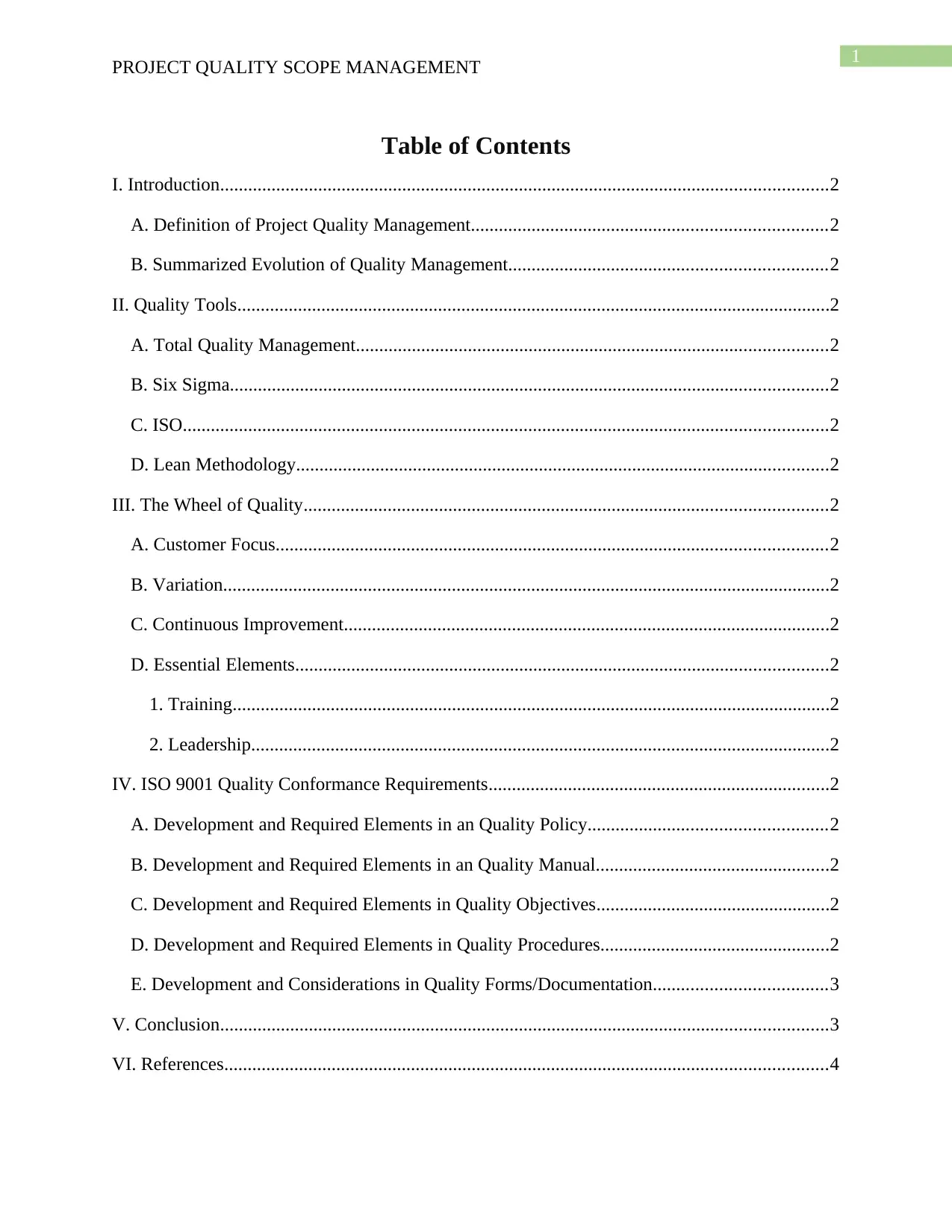
1
PROJECT QUALITY SCOPE MANAGEMENT
Table of Contents
I. Introduction..................................................................................................................................2
A. Definition of Project Quality Management............................................................................2
B. Summarized Evolution of Quality Management....................................................................2
II. Quality Tools...............................................................................................................................2
A. Total Quality Management.....................................................................................................2
B. Six Sigma................................................................................................................................2
C. ISO..........................................................................................................................................2
D. Lean Methodology..................................................................................................................2
III. The Wheel of Quality................................................................................................................2
A. Customer Focus......................................................................................................................2
B. Variation..................................................................................................................................2
C. Continuous Improvement........................................................................................................2
D. Essential Elements..................................................................................................................2
1. Training................................................................................................................................2
2. Leadership............................................................................................................................2
IV. ISO 9001 Quality Conformance Requirements.........................................................................2
A. Development and Required Elements in an Quality Policy...................................................2
B. Development and Required Elements in an Quality Manual..................................................2
C. Development and Required Elements in Quality Objectives..................................................2
D. Development and Required Elements in Quality Procedures.................................................2
E. Development and Considerations in Quality Forms/Documentation.....................................3
V. Conclusion..................................................................................................................................3
VI. References.................................................................................................................................4
PROJECT QUALITY SCOPE MANAGEMENT
Table of Contents
I. Introduction..................................................................................................................................2
A. Definition of Project Quality Management............................................................................2
B. Summarized Evolution of Quality Management....................................................................2
II. Quality Tools...............................................................................................................................2
A. Total Quality Management.....................................................................................................2
B. Six Sigma................................................................................................................................2
C. ISO..........................................................................................................................................2
D. Lean Methodology..................................................................................................................2
III. The Wheel of Quality................................................................................................................2
A. Customer Focus......................................................................................................................2
B. Variation..................................................................................................................................2
C. Continuous Improvement........................................................................................................2
D. Essential Elements..................................................................................................................2
1. Training................................................................................................................................2
2. Leadership............................................................................................................................2
IV. ISO 9001 Quality Conformance Requirements.........................................................................2
A. Development and Required Elements in an Quality Policy...................................................2
B. Development and Required Elements in an Quality Manual..................................................2
C. Development and Required Elements in Quality Objectives..................................................2
D. Development and Required Elements in Quality Procedures.................................................2
E. Development and Considerations in Quality Forms/Documentation.....................................3
V. Conclusion..................................................................................................................................3
VI. References.................................................................................................................................4
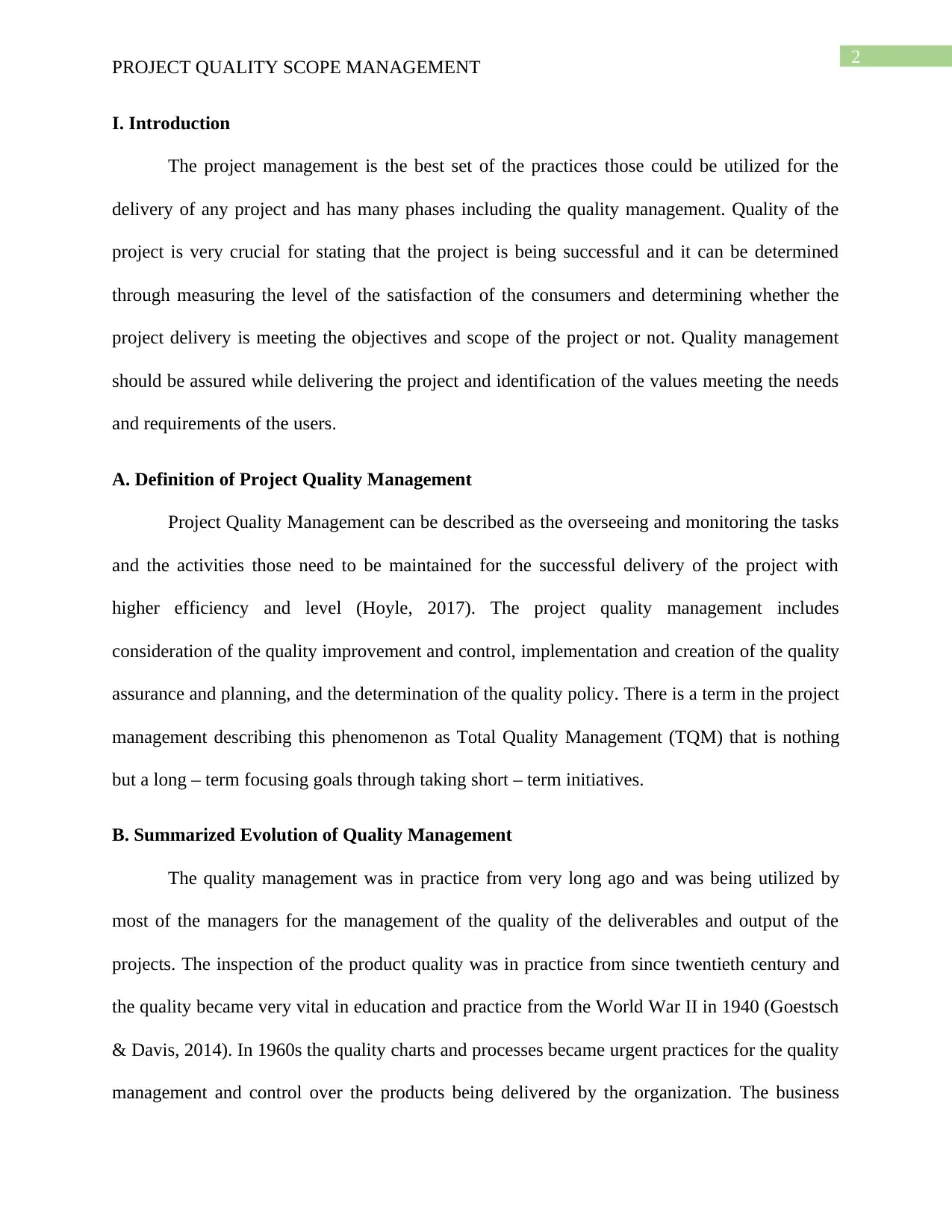
2
PROJECT QUALITY SCOPE MANAGEMENT
I. Introduction
The project management is the best set of the practices those could be utilized for the
delivery of any project and has many phases including the quality management. Quality of the
project is very crucial for stating that the project is being successful and it can be determined
through measuring the level of the satisfaction of the consumers and determining whether the
project delivery is meeting the objectives and scope of the project or not. Quality management
should be assured while delivering the project and identification of the values meeting the needs
and requirements of the users.
A. Definition of Project Quality Management
Project Quality Management can be described as the overseeing and monitoring the tasks
and the activities those need to be maintained for the successful delivery of the project with
higher efficiency and level (Hoyle, 2017). The project quality management includes
consideration of the quality improvement and control, implementation and creation of the quality
assurance and planning, and the determination of the quality policy. There is a term in the project
management describing this phenomenon as Total Quality Management (TQM) that is nothing
but a long – term focusing goals through taking short – term initiatives.
B. Summarized Evolution of Quality Management
The quality management was in practice from very long ago and was being utilized by
most of the managers for the management of the quality of the deliverables and output of the
projects. The inspection of the product quality was in practice from since twentieth century and
the quality became very vital in education and practice from the World War II in 1940 (Goestsch
& Davis, 2014). In 1960s the quality charts and processes became urgent practices for the quality
management and control over the products being delivered by the organization. The business
PROJECT QUALITY SCOPE MANAGEMENT
I. Introduction
The project management is the best set of the practices those could be utilized for the
delivery of any project and has many phases including the quality management. Quality of the
project is very crucial for stating that the project is being successful and it can be determined
through measuring the level of the satisfaction of the consumers and determining whether the
project delivery is meeting the objectives and scope of the project or not. Quality management
should be assured while delivering the project and identification of the values meeting the needs
and requirements of the users.
A. Definition of Project Quality Management
Project Quality Management can be described as the overseeing and monitoring the tasks
and the activities those need to be maintained for the successful delivery of the project with
higher efficiency and level (Hoyle, 2017). The project quality management includes
consideration of the quality improvement and control, implementation and creation of the quality
assurance and planning, and the determination of the quality policy. There is a term in the project
management describing this phenomenon as Total Quality Management (TQM) that is nothing
but a long – term focusing goals through taking short – term initiatives.
B. Summarized Evolution of Quality Management
The quality management was in practice from very long ago and was being utilized by
most of the managers for the management of the quality of the deliverables and output of the
projects. The inspection of the product quality was in practice from since twentieth century and
the quality became very vital in education and practice from the World War II in 1940 (Goestsch
& Davis, 2014). In 1960s the quality charts and processes became urgent practices for the quality
management and control over the products being delivered by the organization. The business
⊘ This is a preview!⊘
Do you want full access?
Subscribe today to unlock all pages.

Trusted by 1+ million students worldwide
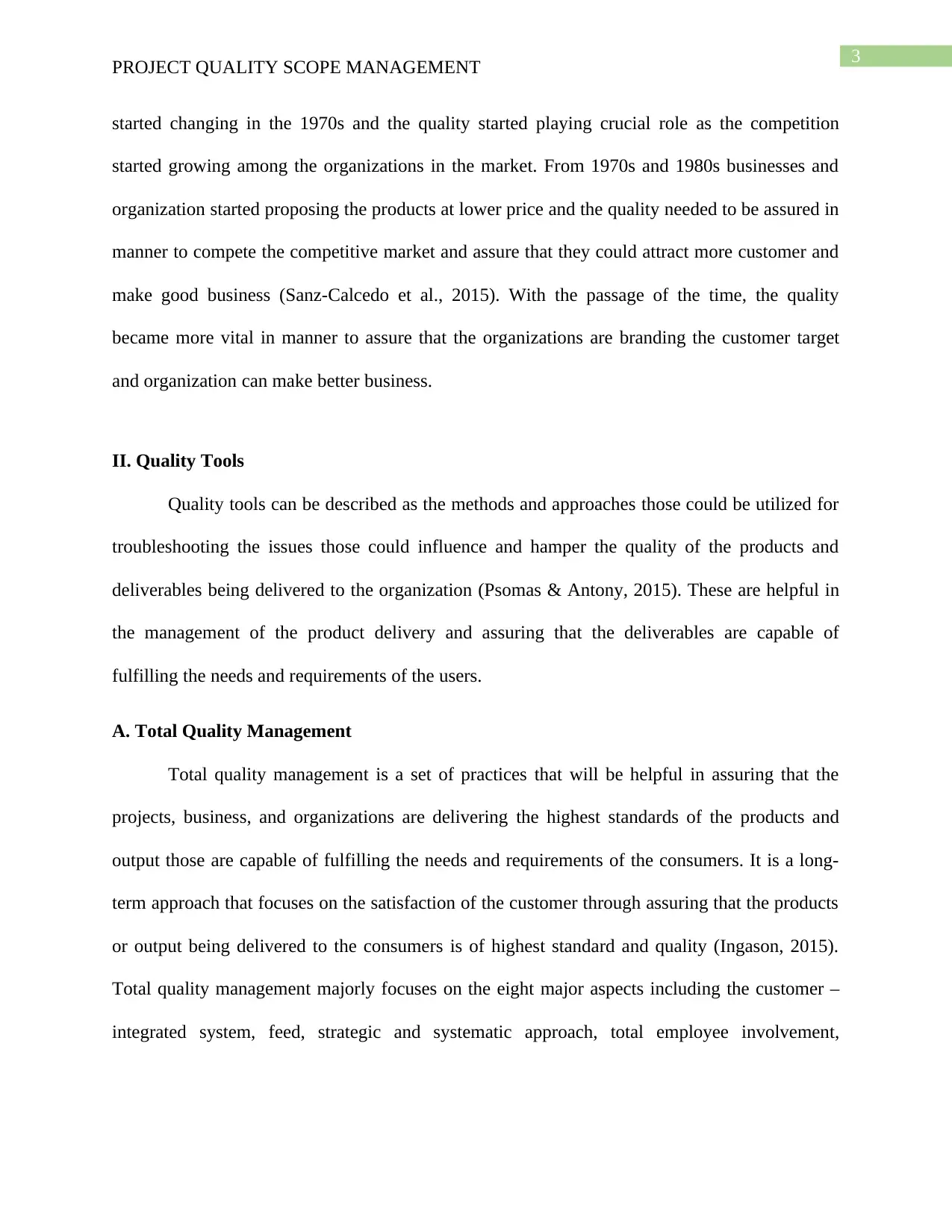
3
PROJECT QUALITY SCOPE MANAGEMENT
started changing in the 1970s and the quality started playing crucial role as the competition
started growing among the organizations in the market. From 1970s and 1980s businesses and
organization started proposing the products at lower price and the quality needed to be assured in
manner to compete the competitive market and assure that they could attract more customer and
make good business (Sanz-Calcedo et al., 2015). With the passage of the time, the quality
became more vital in manner to assure that the organizations are branding the customer target
and organization can make better business.
II. Quality Tools
Quality tools can be described as the methods and approaches those could be utilized for
troubleshooting the issues those could influence and hamper the quality of the products and
deliverables being delivered to the organization (Psomas & Antony, 2015). These are helpful in
the management of the product delivery and assuring that the deliverables are capable of
fulfilling the needs and requirements of the users.
A. Total Quality Management
Total quality management is a set of practices that will be helpful in assuring that the
projects, business, and organizations are delivering the highest standards of the products and
output those are capable of fulfilling the needs and requirements of the consumers. It is a long-
term approach that focuses on the satisfaction of the customer through assuring that the products
or output being delivered to the consumers is of highest standard and quality (Ingason, 2015).
Total quality management majorly focuses on the eight major aspects including the customer –
integrated system, feed, strategic and systematic approach, total employee involvement,
PROJECT QUALITY SCOPE MANAGEMENT
started changing in the 1970s and the quality started playing crucial role as the competition
started growing among the organizations in the market. From 1970s and 1980s businesses and
organization started proposing the products at lower price and the quality needed to be assured in
manner to compete the competitive market and assure that they could attract more customer and
make good business (Sanz-Calcedo et al., 2015). With the passage of the time, the quality
became more vital in manner to assure that the organizations are branding the customer target
and organization can make better business.
II. Quality Tools
Quality tools can be described as the methods and approaches those could be utilized for
troubleshooting the issues those could influence and hamper the quality of the products and
deliverables being delivered to the organization (Psomas & Antony, 2015). These are helpful in
the management of the product delivery and assuring that the deliverables are capable of
fulfilling the needs and requirements of the users.
A. Total Quality Management
Total quality management is a set of practices that will be helpful in assuring that the
projects, business, and organizations are delivering the highest standards of the products and
output those are capable of fulfilling the needs and requirements of the consumers. It is a long-
term approach that focuses on the satisfaction of the customer through assuring that the products
or output being delivered to the consumers is of highest standard and quality (Ingason, 2015).
Total quality management majorly focuses on the eight major aspects including the customer –
integrated system, feed, strategic and systematic approach, total employee involvement,
Paraphrase This Document
Need a fresh take? Get an instant paraphrase of this document with our AI Paraphraser
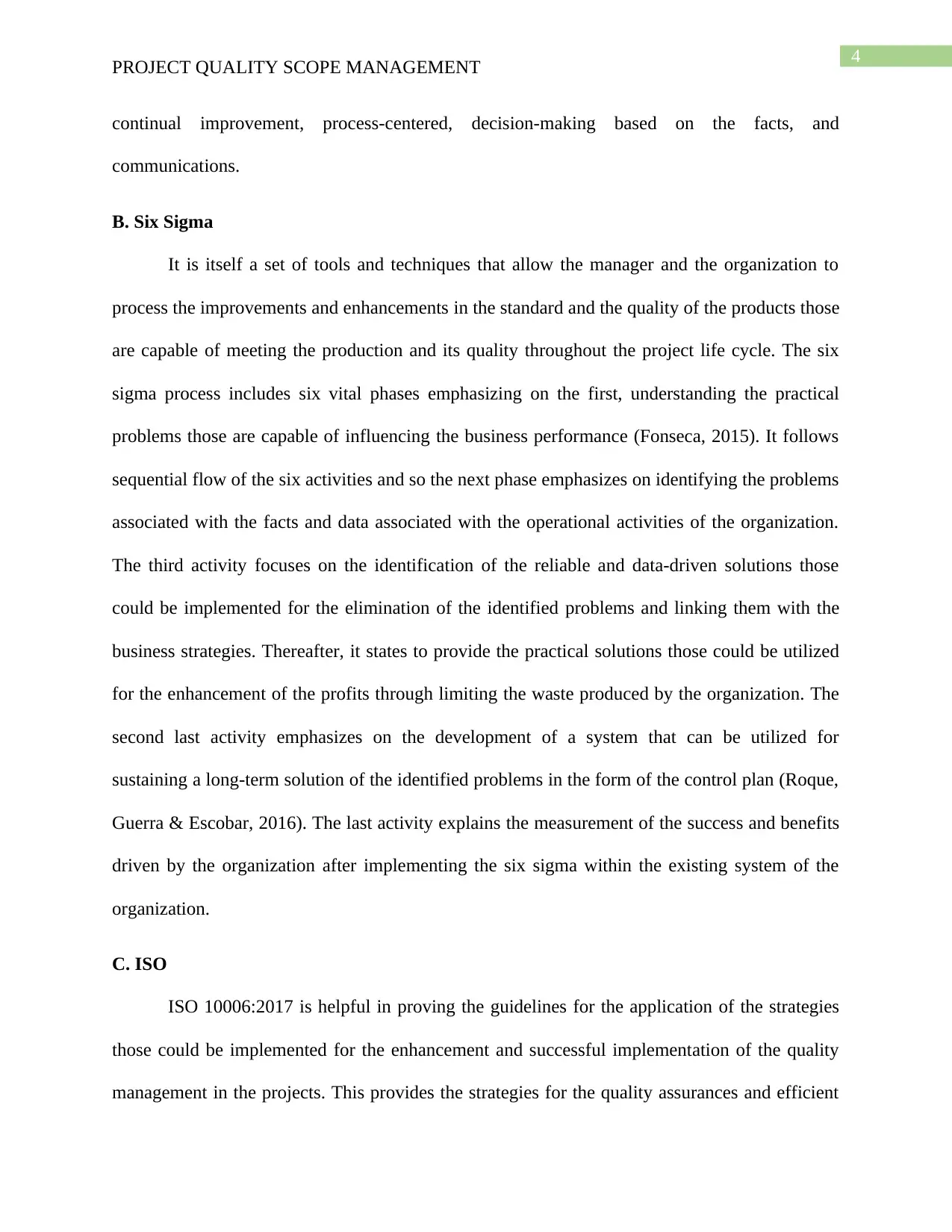
4
PROJECT QUALITY SCOPE MANAGEMENT
continual improvement, process-centered, decision-making based on the facts, and
communications.
B. Six Sigma
It is itself a set of tools and techniques that allow the manager and the organization to
process the improvements and enhancements in the standard and the quality of the products those
are capable of meeting the production and its quality throughout the project life cycle. The six
sigma process includes six vital phases emphasizing on the first, understanding the practical
problems those are capable of influencing the business performance (Fonseca, 2015). It follows
sequential flow of the six activities and so the next phase emphasizes on identifying the problems
associated with the facts and data associated with the operational activities of the organization.
The third activity focuses on the identification of the reliable and data-driven solutions those
could be implemented for the elimination of the identified problems and linking them with the
business strategies. Thereafter, it states to provide the practical solutions those could be utilized
for the enhancement of the profits through limiting the waste produced by the organization. The
second last activity emphasizes on the development of a system that can be utilized for
sustaining a long-term solution of the identified problems in the form of the control plan (Roque,
Guerra & Escobar, 2016). The last activity explains the measurement of the success and benefits
driven by the organization after implementing the six sigma within the existing system of the
organization.
C. ISO
ISO 10006:2017 is helpful in proving the guidelines for the application of the strategies
those could be implemented for the enhancement and successful implementation of the quality
management in the projects. This provides the strategies for the quality assurances and efficient
PROJECT QUALITY SCOPE MANAGEMENT
continual improvement, process-centered, decision-making based on the facts, and
communications.
B. Six Sigma
It is itself a set of tools and techniques that allow the manager and the organization to
process the improvements and enhancements in the standard and the quality of the products those
are capable of meeting the production and its quality throughout the project life cycle. The six
sigma process includes six vital phases emphasizing on the first, understanding the practical
problems those are capable of influencing the business performance (Fonseca, 2015). It follows
sequential flow of the six activities and so the next phase emphasizes on identifying the problems
associated with the facts and data associated with the operational activities of the organization.
The third activity focuses on the identification of the reliable and data-driven solutions those
could be implemented for the elimination of the identified problems and linking them with the
business strategies. Thereafter, it states to provide the practical solutions those could be utilized
for the enhancement of the profits through limiting the waste produced by the organization. The
second last activity emphasizes on the development of a system that can be utilized for
sustaining a long-term solution of the identified problems in the form of the control plan (Roque,
Guerra & Escobar, 2016). The last activity explains the measurement of the success and benefits
driven by the organization after implementing the six sigma within the existing system of the
organization.
C. ISO
ISO 10006:2017 is helpful in proving the guidelines for the application of the strategies
those could be implemented for the enhancement and successful implementation of the quality
management in the projects. This provides the strategies for the quality assurances and efficient
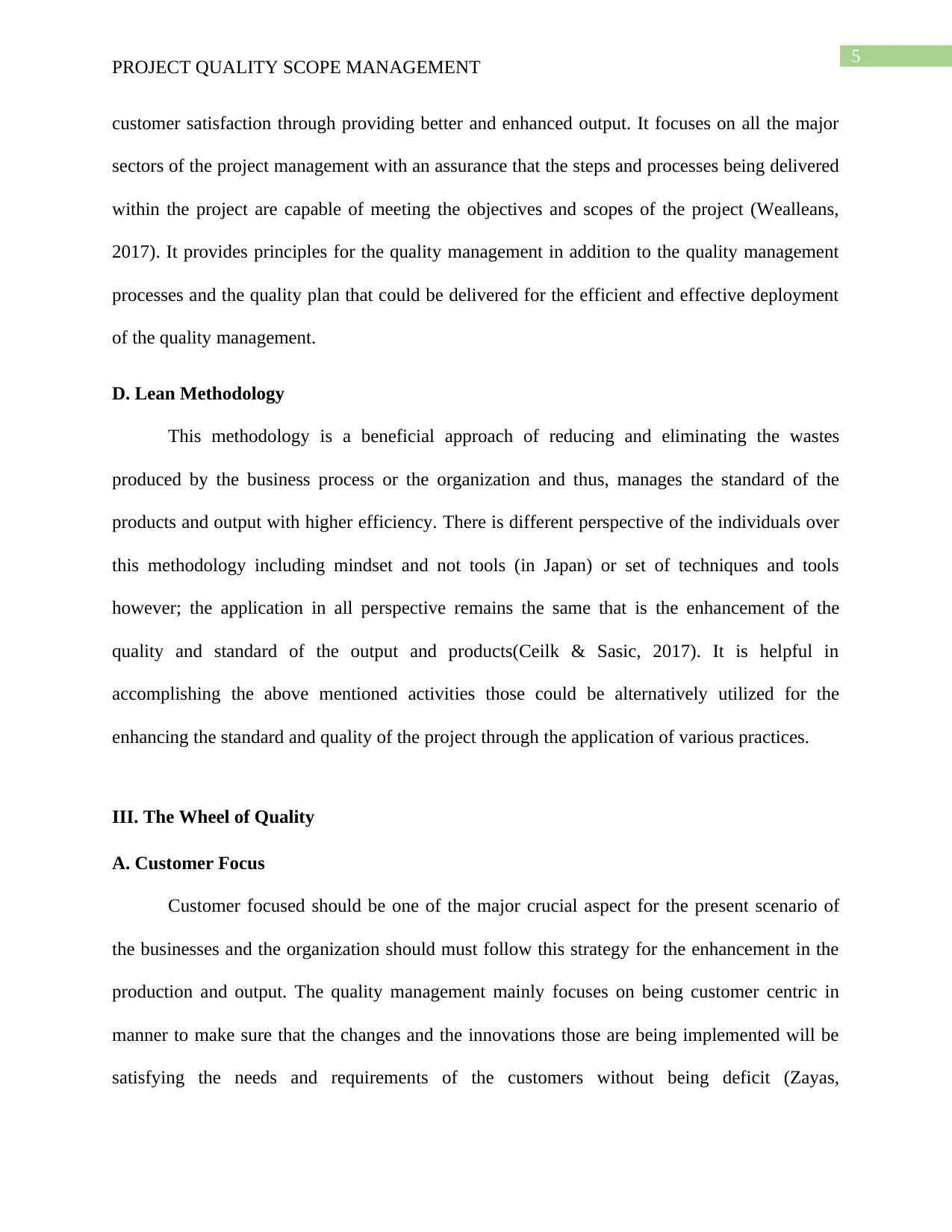
5
PROJECT QUALITY SCOPE MANAGEMENT
customer satisfaction through providing better and enhanced output. It focuses on all the major
sectors of the project management with an assurance that the steps and processes being delivered
within the project are capable of meeting the objectives and scopes of the project (Wealleans,
2017). It provides principles for the quality management in addition to the quality management
processes and the quality plan that could be delivered for the efficient and effective deployment
of the quality management.
D. Lean Methodology
This methodology is a beneficial approach of reducing and eliminating the wastes
produced by the business process or the organization and thus, manages the standard of the
products and output with higher efficiency. There is different perspective of the individuals over
this methodology including mindset and not tools (in Japan) or set of techniques and tools
however; the application in all perspective remains the same that is the enhancement of the
quality and standard of the output and products(Ceilk & Sasic, 2017). It is helpful in
accomplishing the above mentioned activities those could be alternatively utilized for the
enhancing the standard and quality of the project through the application of various practices.
III. The Wheel of Quality
A. Customer Focus
Customer focused should be one of the major crucial aspect for the present scenario of
the businesses and the organization should must follow this strategy for the enhancement in the
production and output. The quality management mainly focuses on being customer centric in
manner to make sure that the changes and the innovations those are being implemented will be
satisfying the needs and requirements of the customers without being deficit (Zayas,
PROJECT QUALITY SCOPE MANAGEMENT
customer satisfaction through providing better and enhanced output. It focuses on all the major
sectors of the project management with an assurance that the steps and processes being delivered
within the project are capable of meeting the objectives and scopes of the project (Wealleans,
2017). It provides principles for the quality management in addition to the quality management
processes and the quality plan that could be delivered for the efficient and effective deployment
of the quality management.
D. Lean Methodology
This methodology is a beneficial approach of reducing and eliminating the wastes
produced by the business process or the organization and thus, manages the standard of the
products and output with higher efficiency. There is different perspective of the individuals over
this methodology including mindset and not tools (in Japan) or set of techniques and tools
however; the application in all perspective remains the same that is the enhancement of the
quality and standard of the output and products(Ceilk & Sasic, 2017). It is helpful in
accomplishing the above mentioned activities those could be alternatively utilized for the
enhancing the standard and quality of the project through the application of various practices.
III. The Wheel of Quality
A. Customer Focus
Customer focused should be one of the major crucial aspect for the present scenario of
the businesses and the organization should must follow this strategy for the enhancement in the
production and output. The quality management mainly focuses on being customer centric in
manner to make sure that the changes and the innovations those are being implemented will be
satisfying the needs and requirements of the customers without being deficit (Zayas,
⊘ This is a preview!⊘
Do you want full access?
Subscribe today to unlock all pages.

Trusted by 1+ million students worldwide
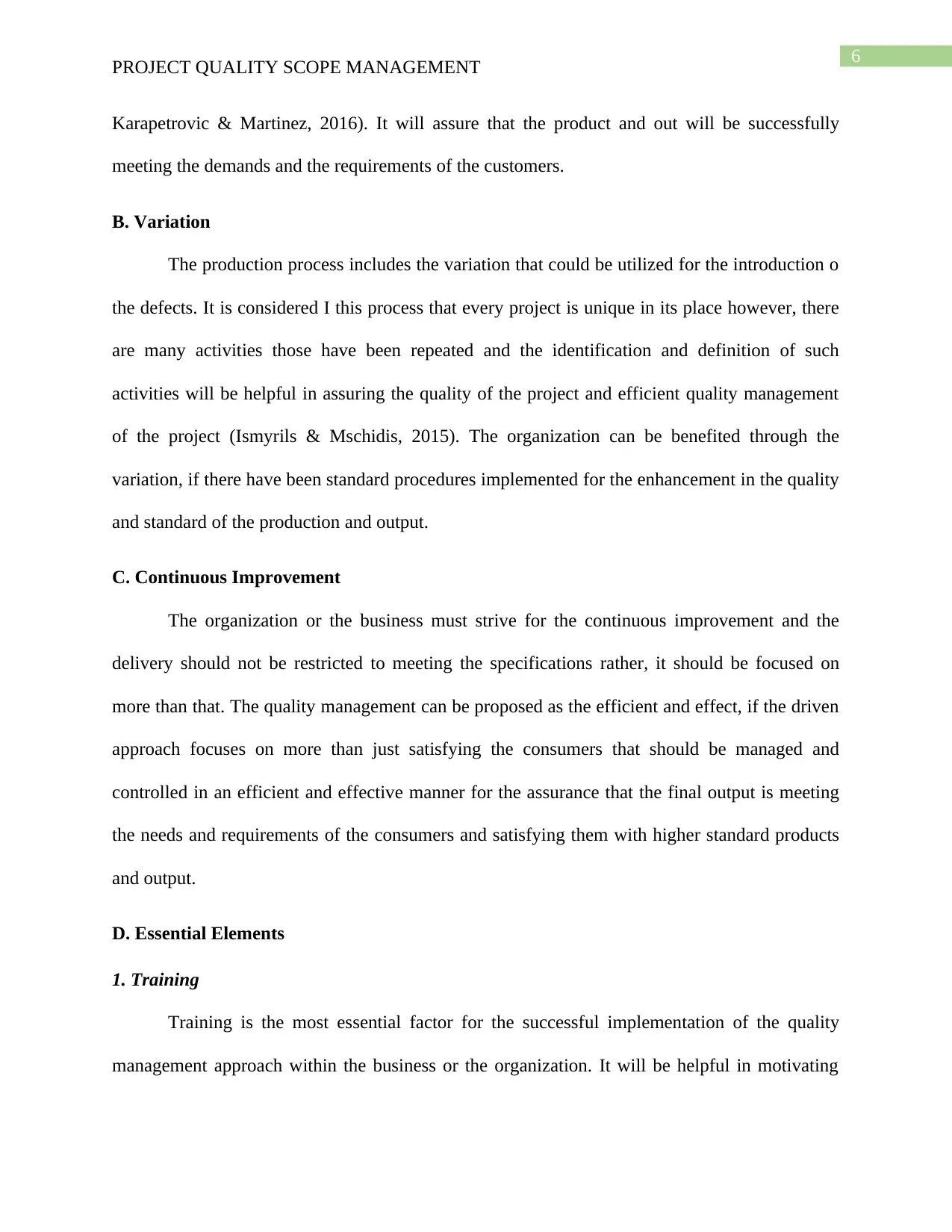
6
PROJECT QUALITY SCOPE MANAGEMENT
Karapetrovic & Martinez, 2016). It will assure that the product and out will be successfully
meeting the demands and the requirements of the customers.
B. Variation
The production process includes the variation that could be utilized for the introduction o
the defects. It is considered I this process that every project is unique in its place however, there
are many activities those have been repeated and the identification and definition of such
activities will be helpful in assuring the quality of the project and efficient quality management
of the project (Ismyrils & Mschidis, 2015). The organization can be benefited through the
variation, if there have been standard procedures implemented for the enhancement in the quality
and standard of the production and output.
C. Continuous Improvement
The organization or the business must strive for the continuous improvement and the
delivery should not be restricted to meeting the specifications rather, it should be focused on
more than that. The quality management can be proposed as the efficient and effect, if the driven
approach focuses on more than just satisfying the consumers that should be managed and
controlled in an efficient and effective manner for the assurance that the final output is meeting
the needs and requirements of the consumers and satisfying them with higher standard products
and output.
D. Essential Elements
1. Training
Training is the most essential factor for the successful implementation of the quality
management approach within the business or the organization. It will be helpful in motivating
PROJECT QUALITY SCOPE MANAGEMENT
Karapetrovic & Martinez, 2016). It will assure that the product and out will be successfully
meeting the demands and the requirements of the customers.
B. Variation
The production process includes the variation that could be utilized for the introduction o
the defects. It is considered I this process that every project is unique in its place however, there
are many activities those have been repeated and the identification and definition of such
activities will be helpful in assuring the quality of the project and efficient quality management
of the project (Ismyrils & Mschidis, 2015). The organization can be benefited through the
variation, if there have been standard procedures implemented for the enhancement in the quality
and standard of the production and output.
C. Continuous Improvement
The organization or the business must strive for the continuous improvement and the
delivery should not be restricted to meeting the specifications rather, it should be focused on
more than that. The quality management can be proposed as the efficient and effect, if the driven
approach focuses on more than just satisfying the consumers that should be managed and
controlled in an efficient and effective manner for the assurance that the final output is meeting
the needs and requirements of the consumers and satisfying them with higher standard products
and output.
D. Essential Elements
1. Training
Training is the most essential factor for the successful implementation of the quality
management approach within the business or the organization. It will be helpful in motivating
Paraphrase This Document
Need a fresh take? Get an instant paraphrase of this document with our AI Paraphraser

7
PROJECT QUALITY SCOPE MANAGEMENT
the players within the organization to be motivated and take the best step that could lead this
implementation in an efficient and effective manner (Ismyril, Mschidis & Tsiotras, 2015).
2. Leadership
Better leadership is the key of delivering the high standard and quality product and output
that can assure the enhancement in the quality and production of the better and efficient approach
those could lead the business and the organization to a success
IV. ISO 9001 Quality Conformance Requirements
A. Development and Required Elements in an Quality Policy
The organization can only count in the management of the high standard and quality
through the development of the quality policy assuring that the activities and operations going on
are capable of meeting the consumers’ needs and requirements to whom the delivery of the
products will be made (Castka & balzarova, 2018). There are two most crucial requirements for
the development of the sophisticated quality policy including assurance that the policy being
build is based on the corporate values and objectives. The proposed policy must be integrated
with the concepts of quality management.
B. Development and Required Elements in an Quality Manual
The quality manual should be describing the following aspects for the standard of the
output and production of the organization assuring that the output being delivered is of high
standard:
The exact ad proper scope of the quality management system (Bernardo et al., 2015)
PROJECT QUALITY SCOPE MANAGEMENT
the players within the organization to be motivated and take the best step that could lead this
implementation in an efficient and effective manner (Ismyril, Mschidis & Tsiotras, 2015).
2. Leadership
Better leadership is the key of delivering the high standard and quality product and output
that can assure the enhancement in the quality and production of the better and efficient approach
those could lead the business and the organization to a success
IV. ISO 9001 Quality Conformance Requirements
A. Development and Required Elements in an Quality Policy
The organization can only count in the management of the high standard and quality
through the development of the quality policy assuring that the activities and operations going on
are capable of meeting the consumers’ needs and requirements to whom the delivery of the
products will be made (Castka & balzarova, 2018). There are two most crucial requirements for
the development of the sophisticated quality policy including assurance that the policy being
build is based on the corporate values and objectives. The proposed policy must be integrated
with the concepts of quality management.
B. Development and Required Elements in an Quality Manual
The quality manual should be describing the following aspects for the standard of the
output and production of the organization assuring that the output being delivered is of high
standard:
The exact ad proper scope of the quality management system (Bernardo et al., 2015)
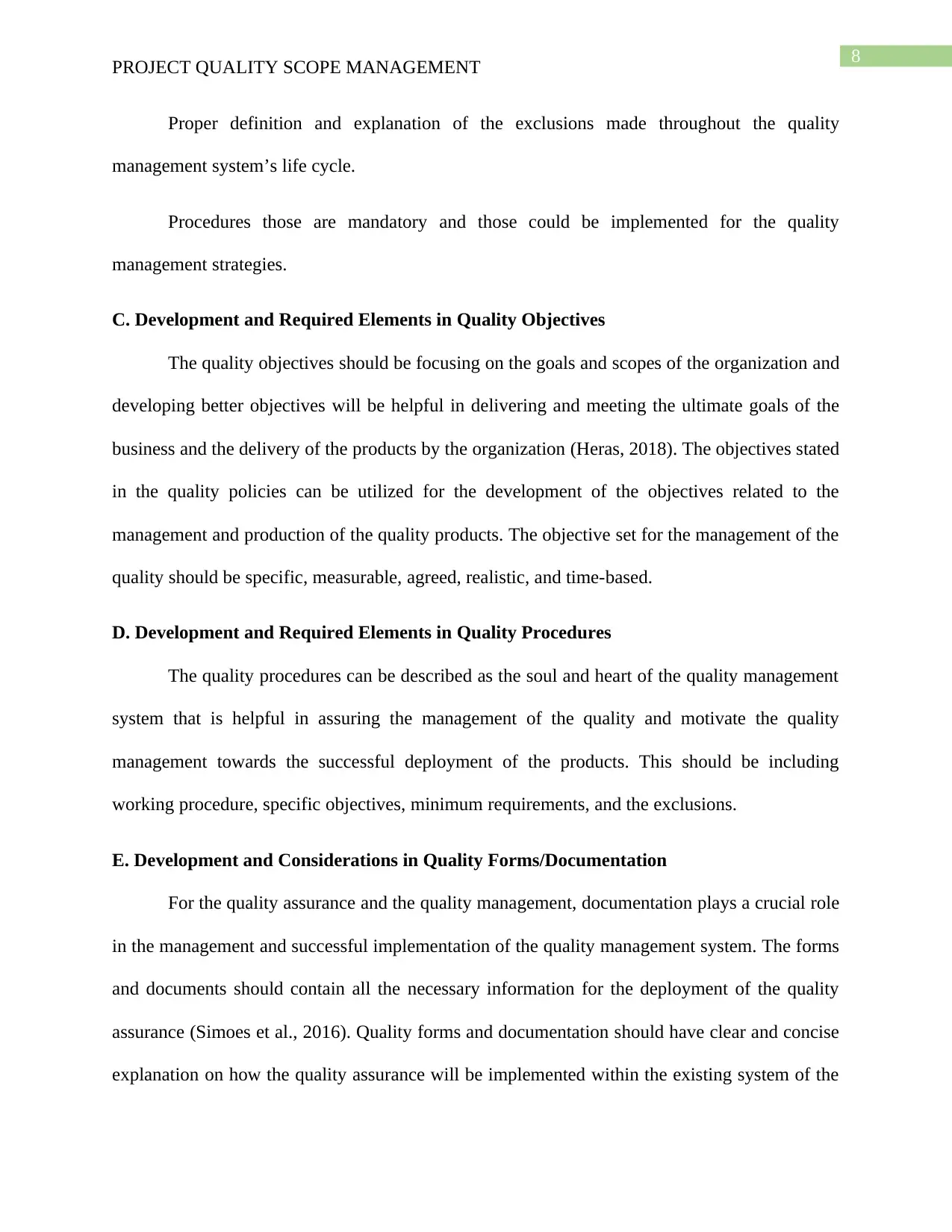
8
PROJECT QUALITY SCOPE MANAGEMENT
Proper definition and explanation of the exclusions made throughout the quality
management system’s life cycle.
Procedures those are mandatory and those could be implemented for the quality
management strategies.
C. Development and Required Elements in Quality Objectives
The quality objectives should be focusing on the goals and scopes of the organization and
developing better objectives will be helpful in delivering and meeting the ultimate goals of the
business and the delivery of the products by the organization (Heras, 2018). The objectives stated
in the quality policies can be utilized for the development of the objectives related to the
management and production of the quality products. The objective set for the management of the
quality should be specific, measurable, agreed, realistic, and time-based.
D. Development and Required Elements in Quality Procedures
The quality procedures can be described as the soul and heart of the quality management
system that is helpful in assuring the management of the quality and motivate the quality
management towards the successful deployment of the products. This should be including
working procedure, specific objectives, minimum requirements, and the exclusions.
E. Development and Considerations in Quality Forms/Documentation
For the quality assurance and the quality management, documentation plays a crucial role
in the management and successful implementation of the quality management system. The forms
and documents should contain all the necessary information for the deployment of the quality
assurance (Simoes et al., 2016). Quality forms and documentation should have clear and concise
explanation on how the quality assurance will be implemented within the existing system of the
PROJECT QUALITY SCOPE MANAGEMENT
Proper definition and explanation of the exclusions made throughout the quality
management system’s life cycle.
Procedures those are mandatory and those could be implemented for the quality
management strategies.
C. Development and Required Elements in Quality Objectives
The quality objectives should be focusing on the goals and scopes of the organization and
developing better objectives will be helpful in delivering and meeting the ultimate goals of the
business and the delivery of the products by the organization (Heras, 2018). The objectives stated
in the quality policies can be utilized for the development of the objectives related to the
management and production of the quality products. The objective set for the management of the
quality should be specific, measurable, agreed, realistic, and time-based.
D. Development and Required Elements in Quality Procedures
The quality procedures can be described as the soul and heart of the quality management
system that is helpful in assuring the management of the quality and motivate the quality
management towards the successful deployment of the products. This should be including
working procedure, specific objectives, minimum requirements, and the exclusions.
E. Development and Considerations in Quality Forms/Documentation
For the quality assurance and the quality management, documentation plays a crucial role
in the management and successful implementation of the quality management system. The forms
and documents should contain all the necessary information for the deployment of the quality
assurance (Simoes et al., 2016). Quality forms and documentation should have clear and concise
explanation on how the quality assurance will be implemented within the existing system of the
⊘ This is a preview!⊘
Do you want full access?
Subscribe today to unlock all pages.

Trusted by 1+ million students worldwide
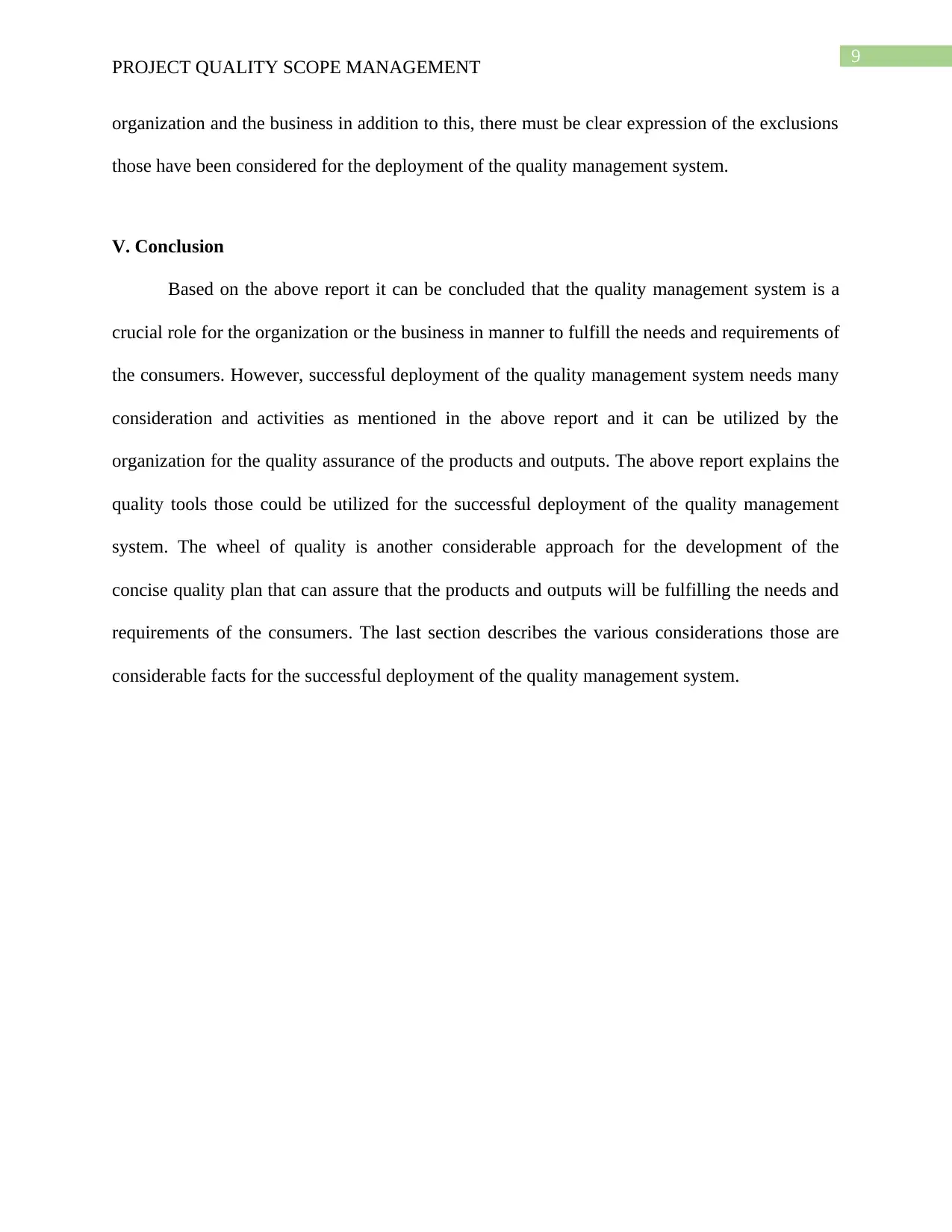
9
PROJECT QUALITY SCOPE MANAGEMENT
organization and the business in addition to this, there must be clear expression of the exclusions
those have been considered for the deployment of the quality management system.
V. Conclusion
Based on the above report it can be concluded that the quality management system is a
crucial role for the organization or the business in manner to fulfill the needs and requirements of
the consumers. However, successful deployment of the quality management system needs many
consideration and activities as mentioned in the above report and it can be utilized by the
organization for the quality assurance of the products and outputs. The above report explains the
quality tools those could be utilized for the successful deployment of the quality management
system. The wheel of quality is another considerable approach for the development of the
concise quality plan that can assure that the products and outputs will be fulfilling the needs and
requirements of the consumers. The last section describes the various considerations those are
considerable facts for the successful deployment of the quality management system.
PROJECT QUALITY SCOPE MANAGEMENT
organization and the business in addition to this, there must be clear expression of the exclusions
those have been considered for the deployment of the quality management system.
V. Conclusion
Based on the above report it can be concluded that the quality management system is a
crucial role for the organization or the business in manner to fulfill the needs and requirements of
the consumers. However, successful deployment of the quality management system needs many
consideration and activities as mentioned in the above report and it can be utilized by the
organization for the quality assurance of the products and outputs. The above report explains the
quality tools those could be utilized for the successful deployment of the quality management
system. The wheel of quality is another considerable approach for the development of the
concise quality plan that can assure that the products and outputs will be fulfilling the needs and
requirements of the consumers. The last section describes the various considerations those are
considerable facts for the successful deployment of the quality management system.
Paraphrase This Document
Need a fresh take? Get an instant paraphrase of this document with our AI Paraphraser
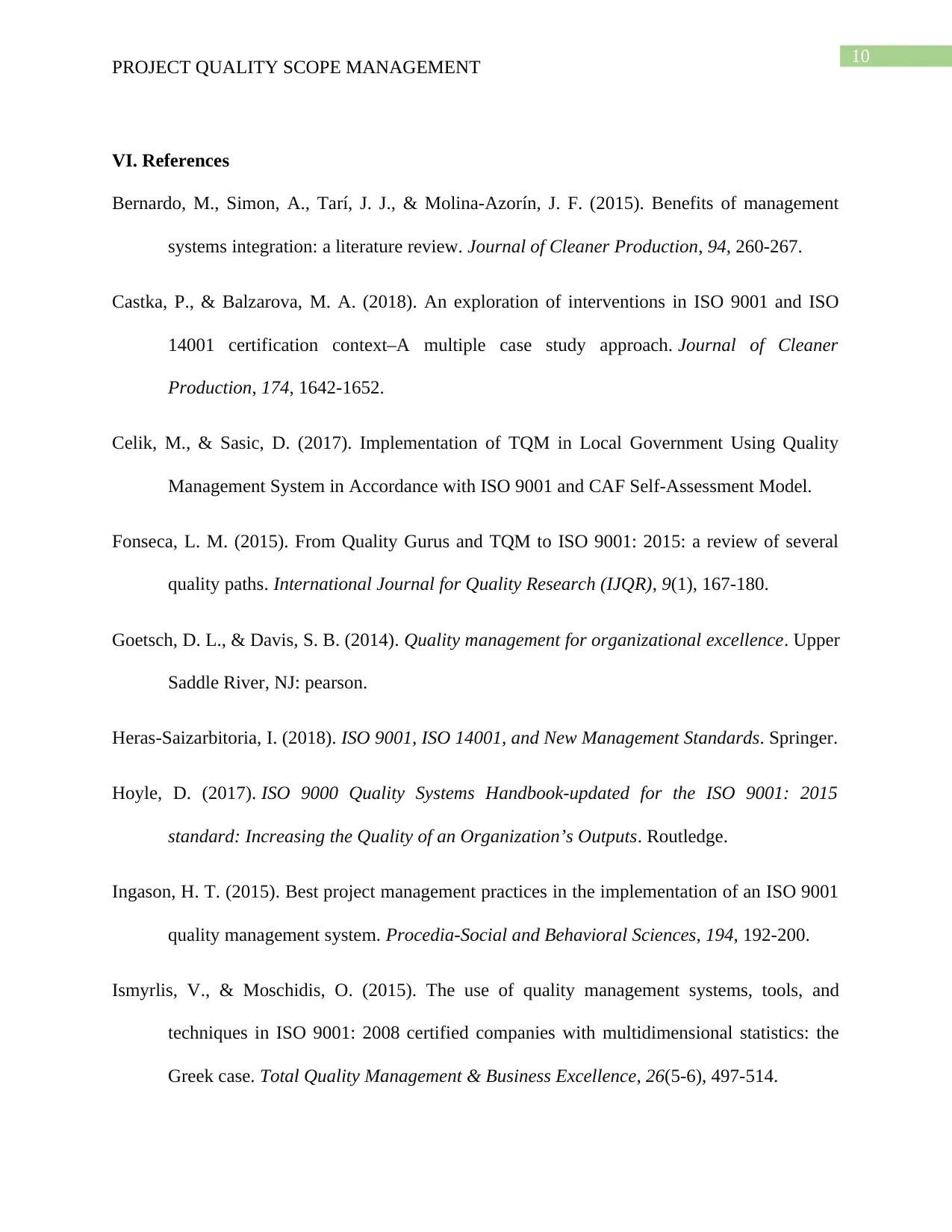
10
PROJECT QUALITY SCOPE MANAGEMENT
VI. References
Bernardo, M., Simon, A., Tarí, J. J., & Molina-Azorín, J. F. (2015). Benefits of management
systems integration: a literature review. Journal of Cleaner Production, 94, 260-267.
Castka, P., & Balzarova, M. A. (2018). An exploration of interventions in ISO 9001 and ISO
14001 certification context–A multiple case study approach. Journal of Cleaner
Production, 174, 1642-1652.
Celik, M., & Sasic, D. (2017). Implementation of TQM in Local Government Using Quality
Management System in Accordance with ISO 9001 and CAF Self-Assessment Model.
Fonseca, L. M. (2015). From Quality Gurus and TQM to ISO 9001: 2015: a review of several
quality paths. International Journal for Quality Research (IJQR), 9(1), 167-180.
Goetsch, D. L., & Davis, S. B. (2014). Quality management for organizational excellence. Upper
Saddle River, NJ: pearson.
Heras-Saizarbitoria, I. (2018). ISO 9001, ISO 14001, and New Management Standards. Springer.
Hoyle, D. (2017). ISO 9000 Quality Systems Handbook-updated for the ISO 9001: 2015
standard: Increasing the Quality of an Organization’s Outputs. Routledge.
Ingason, H. T. (2015). Best project management practices in the implementation of an ISO 9001
quality management system. Procedia-Social and Behavioral Sciences, 194, 192-200.
Ismyrlis, V., & Moschidis, O. (2015). The use of quality management systems, tools, and
techniques in ISO 9001: 2008 certified companies with multidimensional statistics: the
Greek case. Total Quality Management & Business Excellence, 26(5-6), 497-514.
PROJECT QUALITY SCOPE MANAGEMENT
VI. References
Bernardo, M., Simon, A., Tarí, J. J., & Molina-Azorín, J. F. (2015). Benefits of management
systems integration: a literature review. Journal of Cleaner Production, 94, 260-267.
Castka, P., & Balzarova, M. A. (2018). An exploration of interventions in ISO 9001 and ISO
14001 certification context–A multiple case study approach. Journal of Cleaner
Production, 174, 1642-1652.
Celik, M., & Sasic, D. (2017). Implementation of TQM in Local Government Using Quality
Management System in Accordance with ISO 9001 and CAF Self-Assessment Model.
Fonseca, L. M. (2015). From Quality Gurus and TQM to ISO 9001: 2015: a review of several
quality paths. International Journal for Quality Research (IJQR), 9(1), 167-180.
Goetsch, D. L., & Davis, S. B. (2014). Quality management for organizational excellence. Upper
Saddle River, NJ: pearson.
Heras-Saizarbitoria, I. (2018). ISO 9001, ISO 14001, and New Management Standards. Springer.
Hoyle, D. (2017). ISO 9000 Quality Systems Handbook-updated for the ISO 9001: 2015
standard: Increasing the Quality of an Organization’s Outputs. Routledge.
Ingason, H. T. (2015). Best project management practices in the implementation of an ISO 9001
quality management system. Procedia-Social and Behavioral Sciences, 194, 192-200.
Ismyrlis, V., & Moschidis, O. (2015). The use of quality management systems, tools, and
techniques in ISO 9001: 2008 certified companies with multidimensional statistics: the
Greek case. Total Quality Management & Business Excellence, 26(5-6), 497-514.
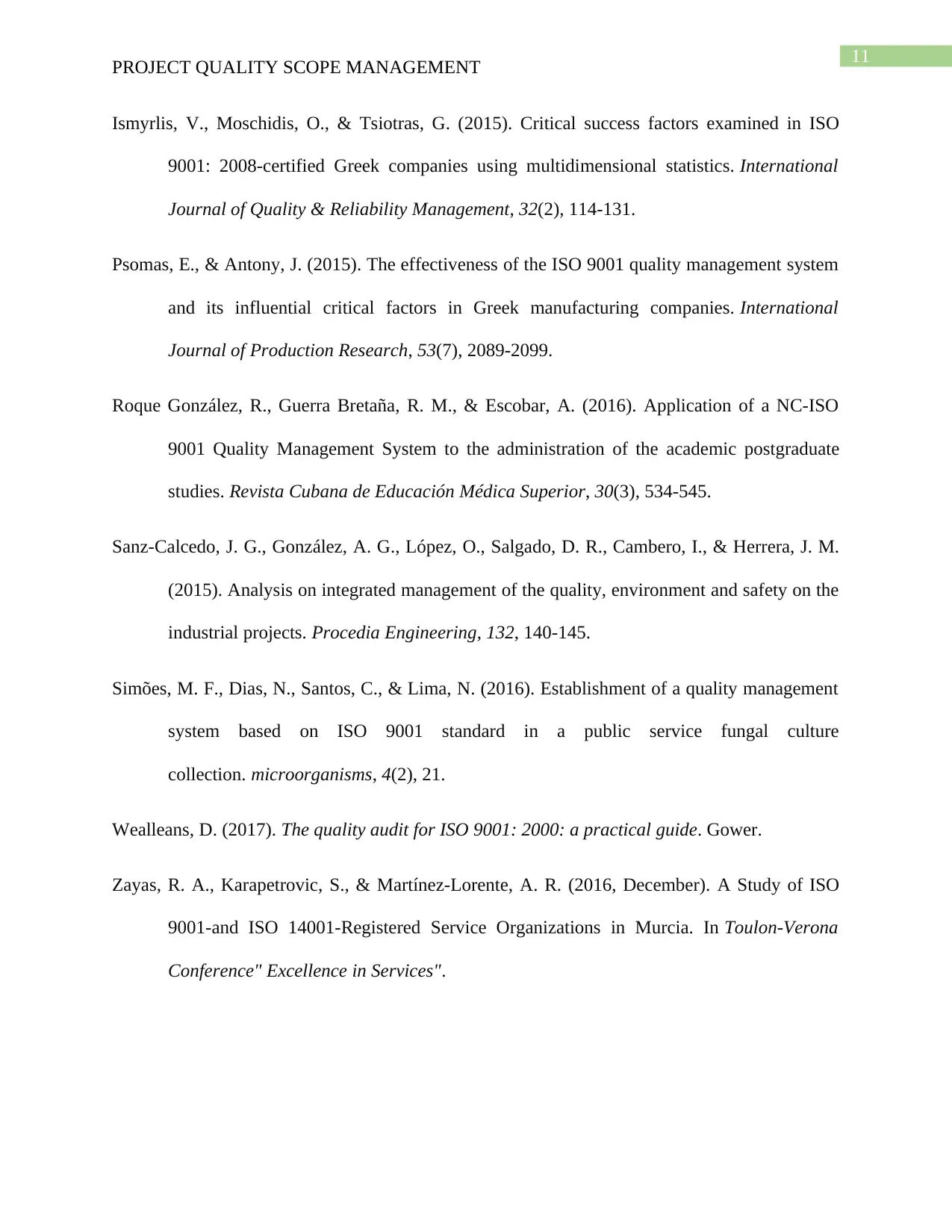
11
PROJECT QUALITY SCOPE MANAGEMENT
Ismyrlis, V., Moschidis, O., & Tsiotras, G. (2015). Critical success factors examined in ISO
9001: 2008-certified Greek companies using multidimensional statistics. International
Journal of Quality & Reliability Management, 32(2), 114-131.
Psomas, E., & Antony, J. (2015). The effectiveness of the ISO 9001 quality management system
and its influential critical factors in Greek manufacturing companies. International
Journal of Production Research, 53(7), 2089-2099.
Roque González, R., Guerra Bretaña, R. M., & Escobar, A. (2016). Application of a NC-ISO
9001 Quality Management System to the administration of the academic postgraduate
studies. Revista Cubana de Educación Médica Superior, 30(3), 534-545.
Sanz-Calcedo, J. G., González, A. G., López, O., Salgado, D. R., Cambero, I., & Herrera, J. M.
(2015). Analysis on integrated management of the quality, environment and safety on the
industrial projects. Procedia Engineering, 132, 140-145.
Simões, M. F., Dias, N., Santos, C., & Lima, N. (2016). Establishment of a quality management
system based on ISO 9001 standard in a public service fungal culture
collection. microorganisms, 4(2), 21.
Wealleans, D. (2017). The quality audit for ISO 9001: 2000: a practical guide. Gower.
Zayas, R. A., Karapetrovic, S., & Martínez-Lorente, A. R. (2016, December). A Study of ISO
9001-and ISO 14001-Registered Service Organizations in Murcia. In Toulon-Verona
Conference" Excellence in Services".
PROJECT QUALITY SCOPE MANAGEMENT
Ismyrlis, V., Moschidis, O., & Tsiotras, G. (2015). Critical success factors examined in ISO
9001: 2008-certified Greek companies using multidimensional statistics. International
Journal of Quality & Reliability Management, 32(2), 114-131.
Psomas, E., & Antony, J. (2015). The effectiveness of the ISO 9001 quality management system
and its influential critical factors in Greek manufacturing companies. International
Journal of Production Research, 53(7), 2089-2099.
Roque González, R., Guerra Bretaña, R. M., & Escobar, A. (2016). Application of a NC-ISO
9001 Quality Management System to the administration of the academic postgraduate
studies. Revista Cubana de Educación Médica Superior, 30(3), 534-545.
Sanz-Calcedo, J. G., González, A. G., López, O., Salgado, D. R., Cambero, I., & Herrera, J. M.
(2015). Analysis on integrated management of the quality, environment and safety on the
industrial projects. Procedia Engineering, 132, 140-145.
Simões, M. F., Dias, N., Santos, C., & Lima, N. (2016). Establishment of a quality management
system based on ISO 9001 standard in a public service fungal culture
collection. microorganisms, 4(2), 21.
Wealleans, D. (2017). The quality audit for ISO 9001: 2000: a practical guide. Gower.
Zayas, R. A., Karapetrovic, S., & Martínez-Lorente, A. R. (2016, December). A Study of ISO
9001-and ISO 14001-Registered Service Organizations in Murcia. In Toulon-Verona
Conference" Excellence in Services".
⊘ This is a preview!⊘
Do you want full access?
Subscribe today to unlock all pages.

Trusted by 1+ million students worldwide
1 out of 12
Related Documents
Your All-in-One AI-Powered Toolkit for Academic Success.
+13062052269
info@desklib.com
Available 24*7 on WhatsApp / Email
![[object Object]](/_next/static/media/star-bottom.7253800d.svg)
Unlock your academic potential
Copyright © 2020–2025 A2Z Services. All Rights Reserved. Developed and managed by ZUCOL.





